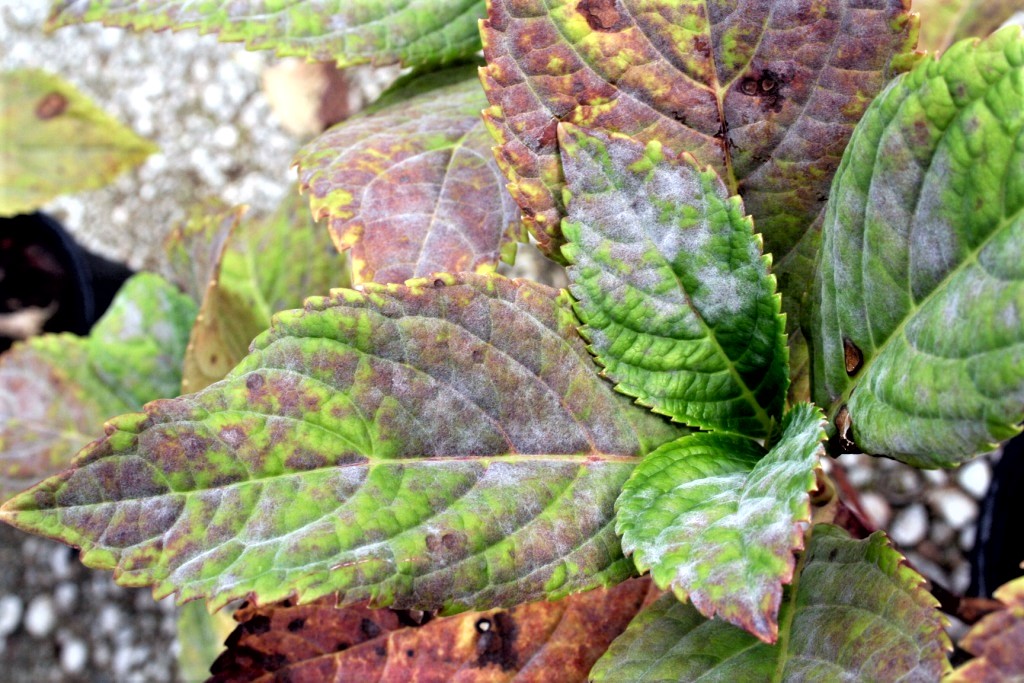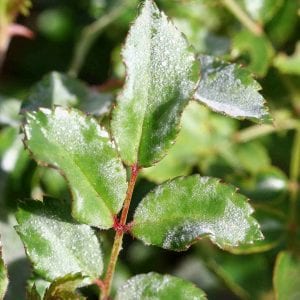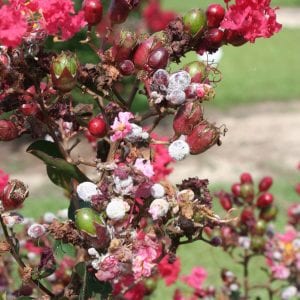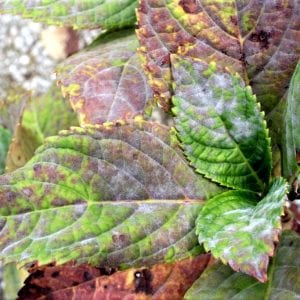Landscaping

Powdery mildew can detract from the beauty of ornamental flowers, woody shrubs, and trees. Learn the symptoms and control methods for this common disease.
Powdery mildew is a common disease on a wide variety of annual and perennial flowers along with woody shrubs and trees across Alabama. A group of closely related, host-specific fungi is the causal agents of this disease. This means that the appearance of the disease on one plant species does not mean that powdery mildew is a threat to other plants in the area. Powdery mildew often detracts from the beauty of many ornamentals and occasionally suppresses plant growth, but rarely leads to plant death.
Woody trees and shrubs susceptible to powdery mildew include azalea (Kurume types), horse chestnut, crapemyrtle (Lagerstroemia indica), crabapple, flowering dogwood, elm, euonymus (Euonymus japonica), bigleaf hydrangea, lilac, oak, peach, pecan, photinia (Chinese), rose, saucer magnolia, and sycamore. African violet, Rieger begonia, chrysanthemum, cineraria, dahlia, delphinium, kalanchoe, phlox, snapdragon, and zinnia are among the more powdery mildew–susceptible annual and perennial flowers.
Symptoms
Small, discrete, white- to buff-colored patches consisting of numerous thread-like strands, called hyphae, appear on tender shoots, buds, and, in some cases, on fruit (figure 1). These patches are often first seen on the upper leaf surface or shoot tip. Eventually, the surface of entire leaves, shoots, or buds may be covered by the cottony, thread-like growth of powdery mildew fungi, which may be associated with leaf discoloration or premature loss of mature leaves.
Tiny, dark brown to black, pepper seed–sized spheres, which are the fungal fruiting bodies, may be visible on the foliage of plants grown outdoors. These structures, called cleistothecia, are rarely seen on plants grown in greenhouses.
Powdery mildew fungi usually attack young leaves, shoots, flowers, buds, and fruit, and occasionally colonize mature foliage. Discolored leaf blotches are sometimes associated with the patches of powdery mildew fungal growth. Distortion, yellowing of foliage, leaf rolling, early leaf drop, and slowed plant growth or stunting are symptoms often seen on seriously damaged plants (figure 2). On crapemyrtle, diseased shoot tips may wither and die. Damage to developing flower buds may greatly reduce floral quality and display (figure 3). Repeated severe mildew infections, especially on some flowers, small shrubs, and tree seedlings, may cause a slow decline in plant health, but cause little if any damage to established trees.
- Figure 1. Discrete powdery mildew colonies on leaves of a shrub rose.
- Figure 2. Flower bud colonization and subsequent bud abortion associated with powdery mildew on crapemyrtle.
- Figure 3. Extensive leaf discoloration associated with heavy powdery mildew colonization of leaves of ‘Nikko Blue’ bigleaf hydrangea.
Fungus Life Cycle
On many woody shrubs and trees, powdery mildew fungi overwinter as dormant hyphae in buds. On other plants, these fungi survive periods of unfavorable weather as dark brown to black fruiting bodies (cleistothecia) embedded in the powdery patches on leaves and shoots.
On greenhouse crops and some evergreen shrubs, powdery mildew fungi persist as hyphal threads on plant foliage. When conditions favor fungal growth, spores arising from infected buds or fruiting bodies are spread by air currents to nearby plants.
Spore germination and the infection of host tissues occur quickly on dry plant surfaces at mild temperatures and at a relative humidity of at least 95 percent. The characteristic cottony patches are usually seen within a few days after infection.
Outdoors, powdery mildew is usually most severe in late spring and early fall when the days are warm, nights are cool, and the rainfall is light. The heaviest powdery mildew outbreaks often occur in humid, shaded locations. This disease may be a year-round problem on some greenhouse-grown crops.
Control
Practices used to control powdery mildew in the landscape, greenhouse, and nursery settings are similar. Cultural practices often slow or prevent disease development. Avoiding excessive applications of nitrogen fertilizer should be emphasized. Disease intensification of powdery mildew has been observed on field-grown flowering dogwood with increasing rates of nitrogen fertilizer. However, powdery mildew–resistant varieties are the best method of disease control. Always ask if the plants you are buying, especially those species most sensitive to powdery mildew, have good disease resistance. Resistant varieties of crapemyrtle and dogwood are listed in table 1.
Table 1. Powdery Mildew–Resistant Small Flowering Trees
2Indicated flowering dogwood cultivars are also resistant to dogwood anthracnose.
3Note, Stellar hybrid dogwoods are hardy only in North Alabama.
| Crapemyrtle | Flowering and Hybrid Dogwood |
|---|---|
| Acoma | Appalachian Joy |
| Apalachee1 | Appalachian Spring2 |
| Basham's Party Pink1 | Aurora2,3 |
| Biloxi | Celestial2,3 |
| Caddo | Cherokee Brave |
| Choctaw | Constellation2,3 |
| Comanche | Erica’s Appalachian Sunrise |
| Fantasy1 | Jean’s Appalachian Snow |
| Hopi | Karen’s Appalachian Blush |
| Lipan | Kay’s Appalachian Mist |
| Miami | Ruth Ellen2,3 |
| Muskogee | Stellar Pink2,3 |
| Natchez | |
| Osage | |
| Pecos | |
| Sarah’s Favorite1 | |
| Sioux | |
| Tonto1 | |
| Tuscarora1 | |
| Tuskegee1 | |
| Wichita1 |
Variegated euonymus (E. japonica) varieties are more resistant to powdery mildew than green, nonvariegated varieties. Hino Crimson, Hinodegiri, and Coral Bells are among the most sensitive of the Kurume-type azaleas to powdery mildew. This disease is rarely seen on Indica- and Satsuki-type azaleas. Powdery mildew–resistant Rieger begonia and kalanchoe varieties have also been identified. Hybrid crapemyrtle (Lagerstroemia fauriei × indica) cultivars are highly resistant to powdery mildew (table 1). Drift roses (except for Coral and White Drift) along with many recently introduced black spot–resistant and shrub roses, Mystic and Ice Meidiland among many others, are also resistant. Cultivars of kousa (Korean) and Stellar hybrid (Cornus florida x kousa) along with the giant dogwood (Cornus controversa) are highly resistant to powdery mildew.
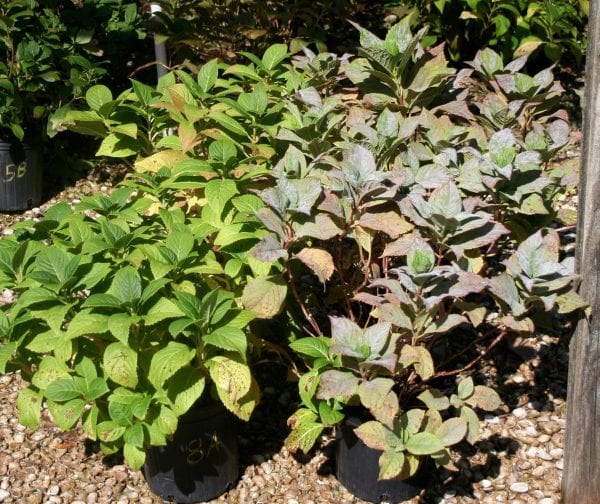
Figure 4. Effectiveness of fungicides in controlling powdery mildew on ‘Nikko Blue’ bigleaf hydrangea with fungicide-treated plant (left) and none fungicide-treated plant (right). Note the colonization of all the leaves by powdery mildew and the premature leaf shed on the none-fungicide–treated plant.
When establishing new landscape beds, plants should be widely spaced in open, sunny areas. Only plant heavily shaded areas with disease-resistant cultivars. In the fall, remove and discard fungus-infested plant debris. This will reduce the risk of carrying over the fungus to the next growing season. Pruning overhanging trees and shrubs to improve air circulation and sunlight penetration will help slow the spread of disease. Maintaining a slow, even growth rate with light, infrequent nitrogen applications will help suppress disease development. Avoid fall nitrogen fertilizer applications, which stimulate new mildew-sensitive growth.
In greenhouse settings, venting and heating at night are necessary to hold the relative humidity below levels needed for spore germination and fungal growth. Also, use fans to improve air circulation. If cultural practices alone do not maintain sufficient disease control, fungicides may be needed to protect susceptible plants from powdery mildew. Generally, good disease control can be obtained with timely fungicide applications (figure 4). Begin fungicide applications on powdery mildew–sensitive plants at or shortly before budbreak or when the white powdery mildew colonies first appear on the leaves, buds, or shoots. Follow a one- to three- week spray schedule, depending on the fungicide chosen and the weather, until conditions no longer favor the spread of disease. Recommended fungicides are listed in table 2. Refer to the product label for specific plants recommended for each fungicide. The addition of a spreader-sticker or a drop of liquid dish detergent is recommended for tank-mixes of fungicides to ensure thorough coverage of the foliage. With all fungicides, allow deposits to dry for 12 hours before watering overhead.
Table 2. Fungicides Recommended for Powdery Mildew Control on Ornamentals in the Home Landscape
| Fungicide | Rate Per Gallon or as Specified in Comments | Comments |
|---|---|---|
Clarified Hydrophobic Extract of Neem Oil
| 1 fl. oz. (2 T.) | Thoroughly mix solution and apply to all plant surfaces (including undersides of leaves) until completely wet at 7- to 10-day intervals. Apply on a 7-day interval when disease is present. Frequently mix solution as you spray. ORMI listed organic product. See label for additional application instructions and plant list. |
copper octanoate
| 1⁄2 to 2.0 fl. oz. | Apply to foliage in 1.1 to 2.3 gallons of water to drip at first sign of disease and repeat applications at 7- to 10-day intervals as needed to control disease. Rainfast in 12 hours. See label for list of host plants. Also labeled for disease control on many vegetables. |
myclobutanil
| 1 fl. oz. (2 T.) | Apply to foliage until wet at first sign of disease and repeat applications at 10- to 14-day intervals until conditions no longer favor disease. Refer to label for list of host plants. Also labeled for the control of selected diseases on home lawns, vegetables, and fruit and nut trees. |
myclobutanil
| 1.5 fl. oz. | Apply to foliage until wet at first sign of disease and repeat applications at 10- to 14-day intervals until conditions no longer favor disease. Refer to label for list of host plants. Also labeled for the control of selected diseases on home lawns, vegetables, and fruit and nut trees. |
potassium bicarbonate
| 2 t. | Apply to foliage until wet at first sign of disease and repeat applications at 10- to 21-day intervals. See label for application rates for specific flowers, shrubs, or trees. Also labeled for disease control on some flowering fruit trees. |
propiconazole
| 1⁄2 to 2.0 fl. oz. (1 to 4 T.) | Apply to foliage until wet at first sign of disease and repeat applications at 10- to 21-day intervals. See label for application rates for specific flowers, shrubs, or trees. Also labeled for disease control on some flowering fruit trees. |
| Liquid Systemic Fungicide | 1⁄2 to 1.5 fl. oz. (1 to 3 T.) | Apply to foliage until wet at first sign of disease and repeat applications at 10- to 14-day intervals until conditions no longer favor disease. Refer to label for list of host plants. Also labeled for the control of selected diseases of home lawns. |
tebuconazole
| 1.0 to 2.0 fl. oz. (1 to 2 T.) | For powdery mildew control on flowers, roses, and woody shrubs. Apply to foliage until wet at first sign of disease and repeat applications at 10- to 14-day intervals until conditions no longer favor disease. Also contains imidacloprid for insect control. Refer to label directions for use and host plants. |
triticonazole
| 3 fl. oz. | Contains acetamiprid for insect control. Apply as soon as insect and disease problems are noticed. Wait 2 to 4 weeks to re-apply if insect and disease problems persist. Do not apply more than 5 times in a season. See label for list of diseases and pests controlled and host plants. |
triticonazole
| 2 fl. oz. (4 T.) | Apply at first sign of disease and repeat as need at 14- to 28-day intervals. Refer to label for list of host plants and additional application guidelines. |
Citations
Hagan, A. K. and J. R. Akridge. 2010. Search for the ‘No Spray’ rose continues. Proc. Southern Nursery Assoc. Res. Conf. 55:430–435
Hagan, A. K., J. R. Akridge, and K. L. Bowen. 2008. Nitrogen rate and flowering dogwood. I. Influence of nitrogen fertilization rate on the occurrence of spot anthracnose, powdery mildew, Cercospora leaf spot and their effect on tree growth. J. Environ. Hort. 26(4):197–203.
Hagan, A. K., J. R. Akridge, J. Ducar, and K. L. Bowen. 2011. Disease resistance and adaptability of stellar and flowering dogwood cultivars at two Alabama sites. J. Environ. Hort. 29(2):169–174.
Hagan, A. K., C. H. Gilliam, G. J. Keever, and J. D. Williams. 1998. Susceptibility of crapemyrtle cultivars to powdery mildew and Cercospora leaf spot in a simulated landscape planting in Alabama. J. Environ. Hort. 16:143–146.
Hagan, A. K., B. Hardin, C. H. Gilliam, G. J. Keever, J. D. Williams, and J. Eakes. 1998. Susceptibility of cultivars of several dogwood taxa to powdery mildew and spot anthracnose. J. Environ. Hort. 16(3):147–151.
Hagan, A. K., M.E. Rivas-Davila, J. R. Akridge, and J. Olive. 2005. Resistance of shrub and groundcover roses to black spot, Cercospora leaf spot, powdery mildew, and impact of fungicide inputs on disease severity. J. Environ. Hort. 23:77–85.
Li, Yonghao, M. T. Mmbaga, A. S. Windham, M. T. Windham, and R. T. Trigiano. 2009. Powdery mildew of dogwoods: Current status and future prospects. Plant Dis. 93:1084–1092.
 Austin Hagan, Professor Emeritus, Auburn University
Austin Hagan, Professor Emeritus, Auburn University
Revised November 2022, Controlling Powdery Mildew on Ornamentals, ANR-0407

